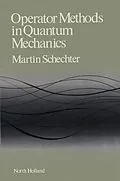Operator Methods in Quantum Mechanics demonstrates the power of operator theory as a tool in the study of quantum mechanics. More specifically, it shows how to use algebraic, representation-independent methods to solve one- and three-dimensional problems, including certain relativistic problems. It explains the applications of commutation relations, shift operators, and the virial, hypervirial, and Hellman-Feyman theorems to the calculation of eigenvalues, matrix elements, and wave functions.
Organized into 16 chapters, this book begins by presenting a few simple postulates describing quantum theory and looking at a single particle moving along a straight line. Then, it introduces mathematical techniques that answer questions about the particle. It also discusses the use of spectral theorem in answering various questions concerning observables, along with negative eigenvalues and methods of determining parts of the spectrum or estimating lower bounds. Moreover, it explains the time-independent or stationary-state scattering theory and states, long-range potentials, and completeness and strong completeness. Oscillating potentials, eigenfunction expansions, restricted particles, hard-core potentials, the invariance principle, and the use of trace class operators to treat scattering theory are also described in this book.
This volume is a valuable resource for physicists, as well as students of intermediate quantum mechanics and postgraduate students who want to be acquainted with the algebraic method of solving quantum mechanical problems.
Inhalt
Preface
Acknowledgments
A Message to the Reader
List of Symbols
Chapter 1. One-Dimensional Motion
1.1. Position
1.2. Mathematical Expectation
1.3. Momentum
1.4. Energy
1.5. Observables
1.6. Operators
1.7. Functions of Observables
1.8. Self-Adjoint Operators
1.9. Hilbert Space
1.10. The Spectral Theorem
Exercises
Chapter 2. The Spectrum
2.1. The Resolvent
2.2. Finding the Spectrum
2.3. The Position Operator
2.4. The Momentum Operator
2.5. The Energy Operator
2.6. The Potential
2.7. A Class of Functions
2.8. The Spectrum of H
Exercises
Chapter 3. The Essential Spectrum
3.1. An Example
3.2. A Calculation
3.3. Finding the Eigenvalues
3.4. The Domain of H
3.5. Back to Hilbert Space
3.6. Compact Operators
3.7. Relative Compactness
3.8. Proof of Theorem 3.7.5
Exercises
Chapter 4. The Negative Eigenvalues
4.1. The Possibilities
4.2. Forms Extensions
4.3. The Remaining Proofs
4.4. Negative Eigenvalues
4.5. Existence of Bound States
4.6. Existence of Infinitely Many Bound States
4.7. Existence of Only a Finite Number of Bound States
4.8. Another Criterion
Exercises
Chapter 5. Estimating the Spectrum
5.1. Introduction
5.2. Some Crucial Lemmas
5.3. A Lower Bound for the Spectrum
5.4. Lower Bounds for the Essential Spectrum
5.5. An Inequality
5.6. Bilinear Forms
5.7. Intervals Containing the Essential Spectrum
5.8. Coincidence of the Essential Spectrum with an Interval
5.9. The Harmonic Oscillator
5.10. The Morse Potential
Exercises
Chapter 6. Scattering Theory
6.1. Time Dependence
6.2. Scattering States
6.3. Properties of the Wave Operators
6.4. The Domains of the Wave Operators
6.5. Local Singularities
Exercises
Chapter 7. Long-Range Potentials
7.1. The Coulomb Potential
7.2. Some Examples
7.3. The Estimates
7.4. The Derivatives of V(x)
7.5. The Relationship Between Xt and V(x)
7.6. An Identity
7.7. The Reduction
7.8. Mollifiers
Exercises
Chapter 8. Time-Independent Theory
8.1. The Resolvent Method
8.2. The Theory
8.3. A Simple Criterion
8.4. The Application
Exercises
Chapter 9. Completeness
9.1. Definition
9.2. The Abstract Theory
9.3. Some Identities
9.4. Another Form
9.5. The Unperturbed Resolvent Operator
9.6. The Perturbed Operator
9.7. Compact Operators
9.8. Analytic Dependence
9.9. Projections
9.10. An Analytic Function Theorem
9.11. The Combined Results
9.12. Absolute Continuity
9.13. The Intertwining Relations
9.14. The Application
Exercises
Chapter 10. Strong Completeness
10.1. The More Difficult Problem
10.2. The Abstract Theory
10.3. The Technique
10.4. Verification for the Hamiltonian
10.5. An Extension
10.6. The Principle of Limiting Absorption
Exercises
Chapter 11. Oscillating Potentials
11.1. A Surprise
11.2. The Hamiltonian
11.3. The Estimates
11.4. A Variation
11.5. Examples
Exercises
Chapter 12. Eigenfunction Expansions
12.1. The Usefulness
12.2. The Problem
12.3. Operators on LP
12.4. Weighted LP-Spaces
12.5. Extended Resolvents
12.6. The Formulas
12.7. Some Consequences
12.8. Summary
Exercises
Chapter 13· Restricted Particles
13.1. A Particle Between Walls
13.2. The Energy Levels
13.3. Compact Resolvents
13.4. One Opaque Wall
13.5. Scattering on a Half-Line
13.6. The Spectral Resolution for the Free Particle on a Half-Line
Exercises
Chapter 14. Hard-Core Potentials
14.1. Local Absorption
14.2. The Modified Hamiltonian
14.3. The Resolvent Operator for H1
14.4. The Wave Operators W± (H1 H0)
14.5. Propagation
14.6. Proof of Theorem 14.5.1
14.7. Completeness of the Wave Operators W± , (H1 H0)
14.8. The Wave Operators W± (H, H1)
14.9. A Regularity Theorem
14.10. A Family of Spaces
Exercises
Chapter 15. The Invariance Principle
15.1. Introduction
15.2. A Simple Result
15.3. The Estimates
15.4. An Extension
15.5. Another Form
Exercises
Chapter 16. Trace Class Operators
16.1. The Abstract Theorem
16.2. Some Consequences
16.3. Hilbert-Schmidt Operators
16.4. Verification for the Hamiltonian
Exercises
Appendix A. The Fourier Transform
Exercises A
Appendix B. Hilbert Space
Exercises B
Appendix C. Holder's Inequality and Banach Space
Bibliography
Index
